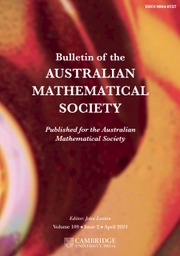No CrossRef data available.
Article contents
DIAGONAL KNOTS AND THE TAU INVARIANT
Published online by Cambridge University Press: 06 February 2025
Abstract
In 2003, Ozsváth, Szabó and Rasmussen introduced the  $\tau $ invariant for knots, and in 2011, Sarkar [‘Grid diagrams and the Ozsváth–Szabó tau-invariant’, Math. Res. Lett. 18(6) (2011), 1239–1257] published a computational shortcut for the
$\tau $ invariant for knots, and in 2011, Sarkar [‘Grid diagrams and the Ozsváth–Szabó tau-invariant’, Math. Res. Lett. 18(6) (2011), 1239–1257] published a computational shortcut for the  $\tau $ invariant of knots that can be represented by diagonal grid diagrams. Previously, the only knots known to have diagonal grid diagram representations were torus knots. We prove that all such knots are positive knots and we produce an example of a knot with a diagonal grid diagram representation which is not a torus knot.
$\tau $ invariant of knots that can be represented by diagonal grid diagrams. Previously, the only knots known to have diagonal grid diagram representations were torus knots. We prove that all such knots are positive knots and we produce an example of a knot with a diagonal grid diagram representation which is not a torus knot.
- Type
- Research Article
- Information
- Copyright
- © The Author(s), 2025. Published by Cambridge University Press on behalf of Australian Mathematical Publishing Association Inc.
Footnotes
This research was funded by Dr. Albert H. and Greta A. Bryan through the 2017 Bryan Summer Research Program at Simpson College.



